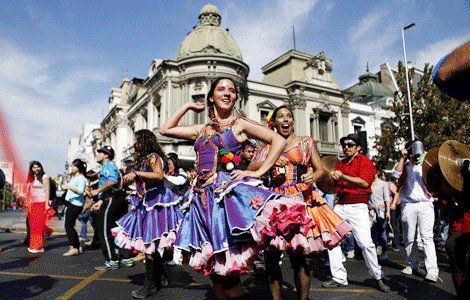Britain forced into F-35 fighter jet U-turn
Updated: 2012-05-10 19:41
(Agencies)
|
||||||||
 |
|
The US Marine Corps version of Lockheed Martin's F35 Joint Strike Fighter, F-35B test aircraft BF-2 flies with external weapons for the first time over the Atlantic test range at Patuxent River Naval Air Systems Command in Maryland in a February 22, 2012 file photo. According to media reports, Britain's government will on May 10, 2012 reverse plans regarding the fast jets that it is buying for future aircraft carriers, abandoning the conventional take-off version F-35C and instead purchasing a version with vertical take-off and landing, the F-35B. [Photo/Agencies] |
LONDON - Britain on Thursday said it would change the type of Lockheed Martin-built Joint Strike Fighter (JSF) aircraft it would buy, a policy shift on a key weapons purchase that risks being seen as another gaffe and further evidence of defence mismanagement.
Amid great fanfare, the government in 2010 launched an ambitious military review meant to set the course for defence over the next five years, but the plan was criticised by many as rushed and ill conceived.
A key measure was to order a type of fighter jet that would require a catapult and arrester wires - dubbed cats and traps - to be installed on one of Britain's two new aircraft carriers, but the system's cost has ballooned since initial estimates.
The ministry's new choice of JSF variant, the F-35B or STOVL variant, takes off and lands vertically and does not require cats and traps, saving the cash-strapped coalition government money. It was the preferred choice of the previous Labour government.
"I can announce to the house today that the National Security Council has decided not to proceed to the cats and traps conversion, but to complete both carriers in the STOVL configuration," Defence Secretary Philip Hammond told parliament.
Lockheed is developing the multirole stealth F-35 for the US military and eight international partners at a projected cost of around $396 billion.

 Relief reaches isolated village
Relief reaches isolated village
 Rainfall poses new threats to quake-hit region
Rainfall poses new threats to quake-hit region
 Funerals begin for Boston bombing victims
Funerals begin for Boston bombing victims
 Quake takeaway from China's Air Force
Quake takeaway from China's Air Force
 Obama celebrates young inventors at science fair
Obama celebrates young inventors at science fair
 Earth Day marked around the world
Earth Day marked around the world
 Volunteer team helping students find sense of normalcy
Volunteer team helping students find sense of normalcy
 Ethnic groups quick to join rescue efforts
Ethnic groups quick to join rescue efforts
Most Viewed
Editor's Picks

|

|

|

|

|

|
Today's Top News
Health new priority for quake zone
Xi meets US top military officer
Japan's boats driven out of Diaoyu
China mulls online shopping legislation
Bird flu death toll rises to 22
Putin appoints new ambassador to China
Japanese ships blocked from Diaoyu Islands
Inspired by Guan, more Chinese pick up golf
US Weekly

|

|






